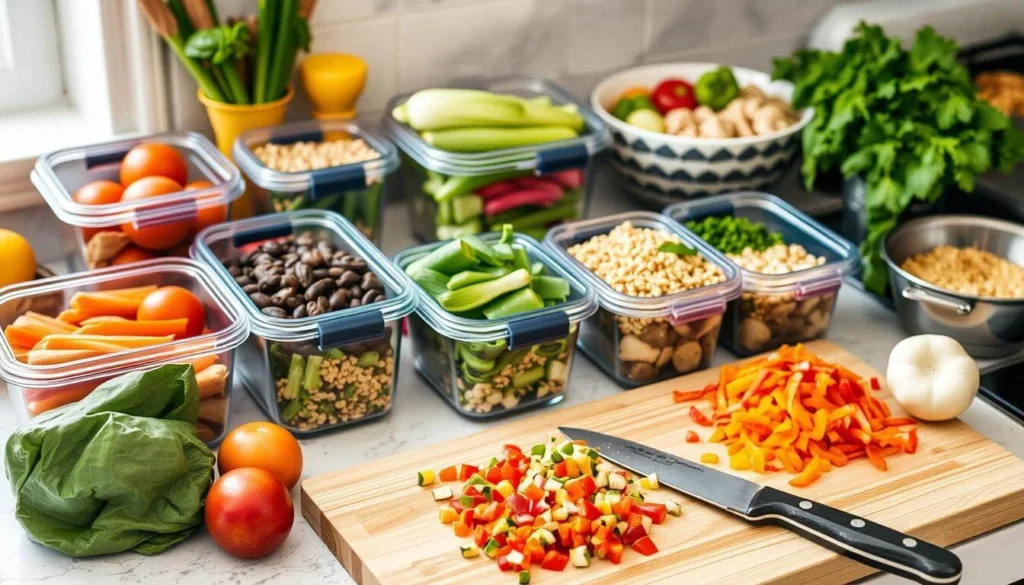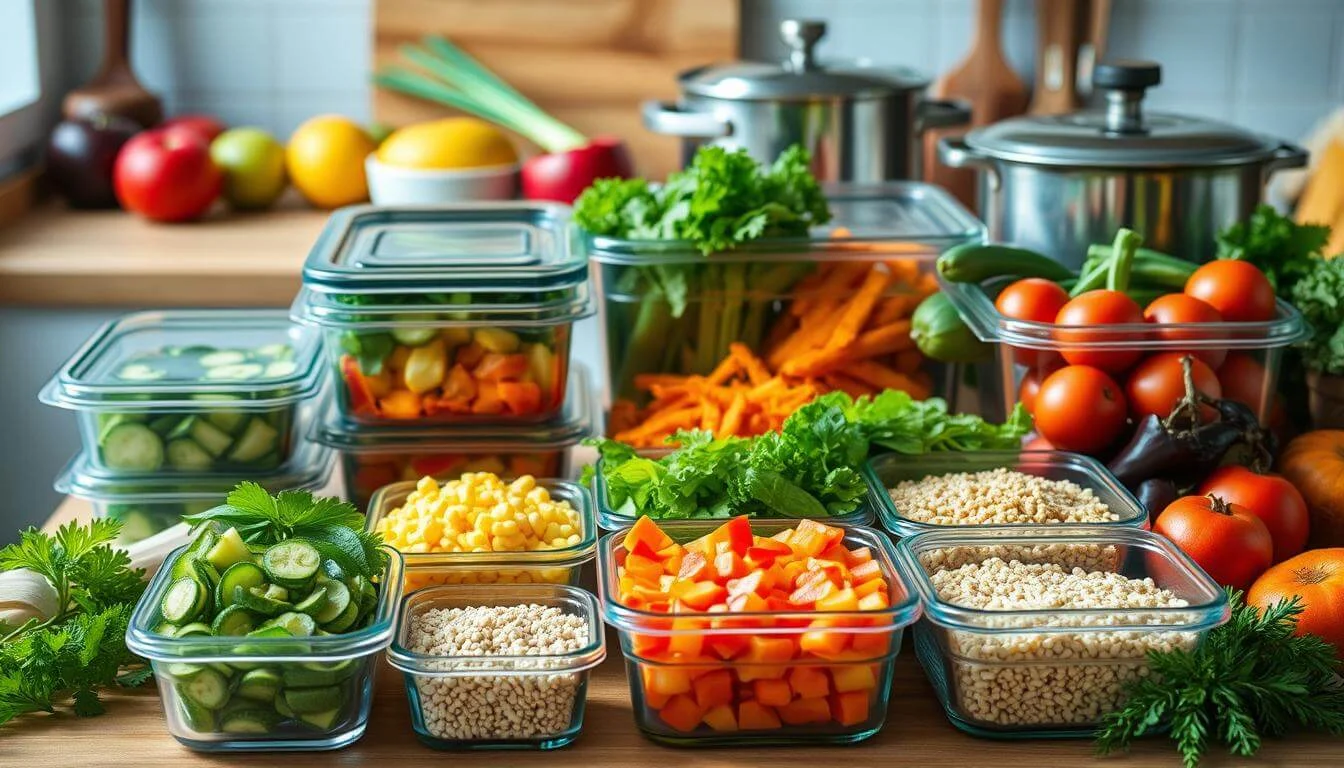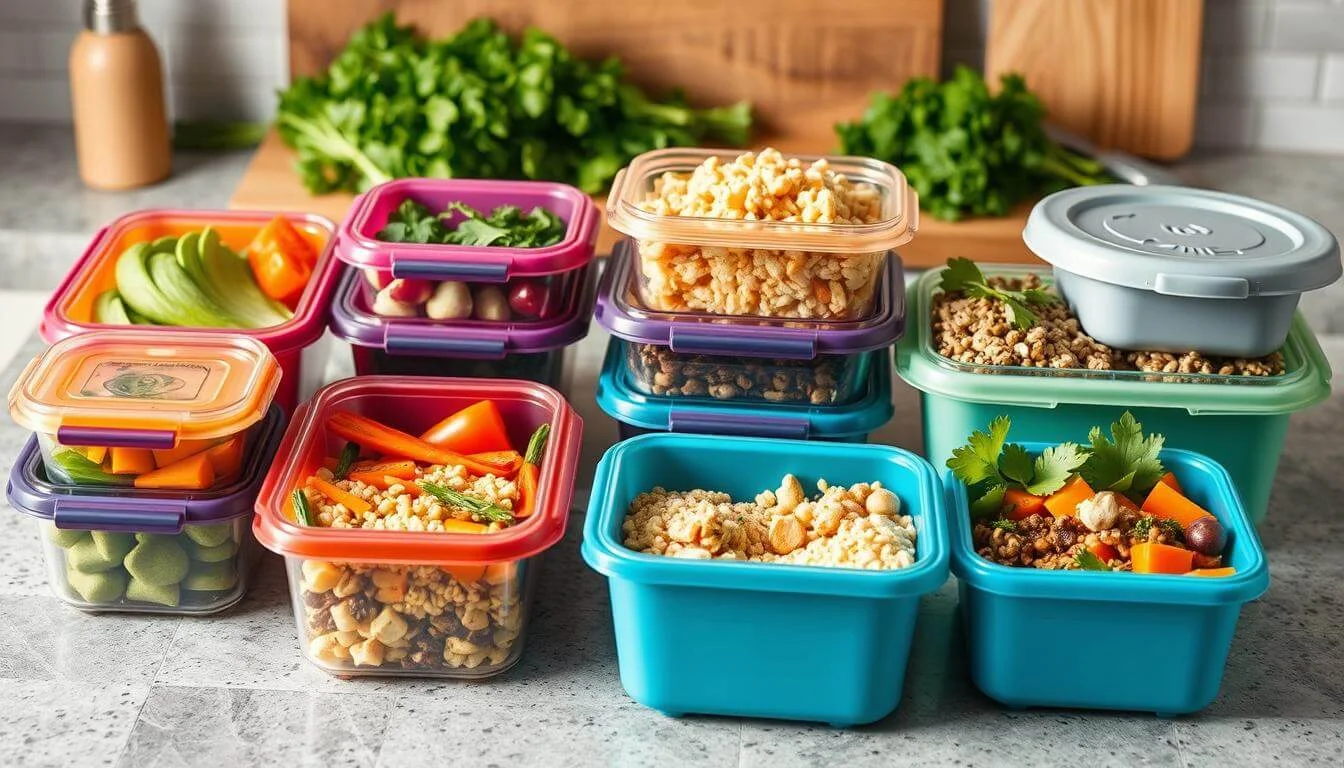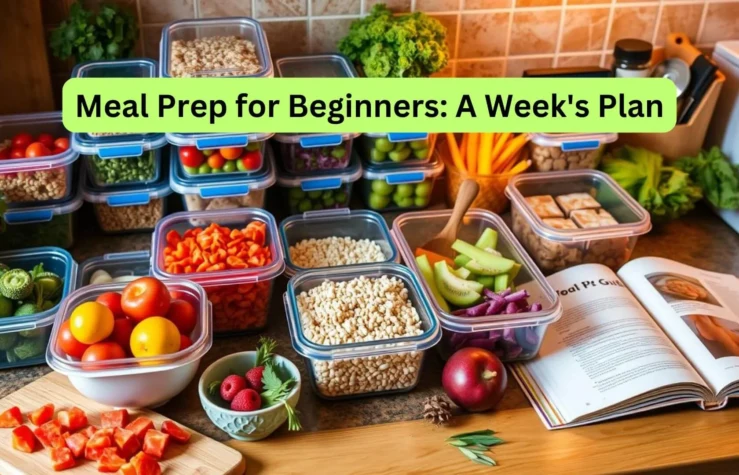Meal prep for beginners is a smart start—it streamlines cooking, promotes healthier eating, and saves both time and money. This guide will show you how to plan meals for a week. It’s a simple way to make your life easier, cut down on waste, and boost your nutrition.
Introduction to Meal Prep
Meal prep for beginners is a great way to make cooking easier. It means preparing meals ahead of time to save time and reduce stress. Many people ask, what is meal prepping? It’s about planning and preparing meals early, helping you eat healthier and make better food choices.
Starting with meal planning might seem hard, but it’s flexible and rewarding. Beginners can tailor their meal prep to fit their tastes and dietary needs. There are many ways to prep meals, like batch cooking, portioning, or prepping ingredients for quick meals. It’s key to try different methods to find what suits you best.
Adding meal prep to your routine makes eating more organized. Start with simple recipes and grow your skills as you get more comfortable. This intro to meal prep will help you understand its benefits and how to plan meals successfully.
Benefits of Meal Prep for Beginners
Meal prep is great for those starting a healthier lifestyle. It brings many benefits that make daily life better. This section will show how meal prep improves health, nutrition, saves time, and money.

Improved Health and Nutrition
Meal prep helps manage diet better. It lets people choose healthier ingredients. This way, they get the right nutrients and avoid overeating. Planning meals ahead means no last-minute unhealthy choices. Meals are ready and nutritious, helping avoid bad eating habits.
Time and Money Savings
Meal prep saves time and money. Cooking in bulk makes meals quicker to prepare. This frees up time for other things. It also cuts down on grocery bills and food waste. Planning meals helps use sales and seasonal produce. This makes food more affordable.
Essential Meal Planning Tips
Meal planning is great for making your week easier and healthier. It helps you shop smarter, waste less food, and eat what you need. By using good meal planning tips, you can make your life simpler.
Creating a Weekly Menu
Having a weekly menu is key to good meal prep. Pick recipes that fit your taste and diet. This saves time and helps you make better choices. Think about planning for:
- Energizing, healthy snacks to fuel your day.
- Balanced meals with lots of different foods.
- Theme nights, like Meatless Mondays, to keep things fun and easy.
Incorporating Variety into Your Meals
Adding variety to your meals keeps your diet interesting and fresh. Here are a few strategies to add variation:
- Change up your ingredients with seasonal and fresh foods.
- Try different proteins like chicken, fish, and plants.
- Use herbs and spices to make the same ingredient into new dishes.
Day | Meal Type | Menu Item |
Monday | Dinner | Grilled Chicken with Quinoa Salad |
Tuesday | Dinner | Veggie Tacos with Salsa |
Wednesday | Dinner | Stir-Fried Tofu with Mixed Vegetables |
Thursday | Dinner | Baked Salmon with Asparagus |
Friday | Dinner | Pasta Primavera |
By following these tips and planning your meals, you’ll enjoy a wide range of healthy dishes. Keep things interesting by trying new things. This will keep you excited about cooking.

Meal Prep for Beginners: Fundamental Steps
Starting your meal prep journey is exciting. First, you need to know the basics. This includes the kitchen tools you’ll need and the recipes you’ll make. Begin by checking what tools you have and how they can help you cook better. This simple trick streamlines your meal prep, saving you time and effort each week. Here are some ways to mix things up:
Assessing Your Kitchen Supplies
Before you start meal prep, check your kitchen tools. Your experience can be significantly enhanced with the correct tools. You’ll need:
- High-quality cutting boards
- Sharp kitchen knives
- Measuring cups and spoons
- Mixing bowls
- Storage containers with airtight seals
These tools will help you prepare a variety of meals easily. Investing in a few good, versatile items will also boost your efficiency.
Choosing the Right Recipes
With your tools ready, it’s time to pick your recipes. Look for meals that can be cooked in bulk and stored well. Choose recipes that use whole ingredients and fit your dietary goals. Here are some tips for picking recipes:
- Find meals that cook quickly.
- Choose ingredients that work in many recipes.
- Go for recipes that taste good even when reheated.
This guide will help you find great recipes for meal prep. This way, your prep work will be rewarding and effective.
Recipe Type | Cooking Time | Storage Method |
Grain Bowls | 30 minutes | Glass containers |
Soups | 45 minutes | Freezer-safe bags |
Stir-fries | 20 minutes | Plastic containers |
Quick Meal Prep Recipes
For beginners, quick meal prep recipes can make your week easier. They offer nutritious meals with little time and effort. Here are some easy breakfasts, healthy lunches, and dinners that save time but don’t lose flavor.
Simple Breakfast Options
- Overnight Oats: Mix rolled oats, yogurt, and fruits. Refrigerate overnight for a quick breakfast.
- Egg Muffins: Blend eggs with finely chopped vegetables and shredded cheese, then pour into a muffin tin for a quick, oven-baked breakfast bite. These make the ideal quick meal.
Healthy Lunch Ideas
- Grain Bowls: Layer cooked grains, protein, and veggies. Add your favorite dressing on top.
- Wraps: Wrap up lean proteins, fresh greens, and a tasty spread in whole-grain tortillas—a convenient, packable option for busy workdays.
Dinner Recipes That Save Time
- Sheet Pan Veggies and Protein: Roast protein and veggies on one sheet. Easy cleanup and quick cooking.
- Stir-Fry: Cook veggies and protein in a skillet. Use a store-bought sauce for a quick meal over rice or noodles.
These quick meal prep recipes keep healthy meals ready at any time. They help you stick to your diet goals.
| Meal Type | Recipe | Prep Time | Notes |
|---|---|---|---|
| Breakfast | Overnight Oats | 5 minutes | Make the night before for an easy start to your day. |
| Breakfast | Egg Muffins | 15 minutes | Great for meal prepping; store in the fridge. |
| Lunch | Grain Bowls | 10 minutes | Customize with your favorite toppings. |
| Lunch | Wraps | 15 minutes | Perfect for packing; add variety with fillings. |
| Dinner | Sheet Pan Veggies. | 30 minutes | Minimal clean-up with one-pan cooking. |
| Dinner | Stir-Fry | 20 minutes | Fast and versatile, use any protein and veggies. |
Healthy Meal Prepping: Nutritional Considerations
Healthy meal prepping means paying attention to nutritional balance. It’s important to understand macronutrient balance for a nutritious diet. Proteins, lipids, and carbohydrates are all essential to your body. Knowing how to mix these macronutrients in your meals helps you reach your dietary goals.
Balancing Macronutrients
To get the most out of meal prepping, aim for a balanced mix of macronutrients in each meal. A good rule of thumb is:
| Macronutrient | Recommended Intake |
|---|---|
| Carbohydrates | 45-65% of total daily calories |
| Proteins | 10-35% of total daily calories |
| Fats | 20-35% of total daily calories |
Adjust these percentages if you have specific health goals, like losing weight or building muscle. This will make meal prep even more effective.
Portion Control Strategies
Controlling portions in meal prep is key to eating the right amount. Here are some tips:
- Use measuring tools like cups and spoons to standardize portions.
- Employ visual cues, such as filling half your plate with vegetables.
- Refer to dietary guidelines based on caloric needs for accurate portion sizes.
Using these strategies helps you maintain a healthy meal prepping routine. It keeps your macronutrient balance in check and supports your health goals.
Budget-Friendly Meal Prep Strategies
Using budget-friendly meal prep strategies can cut down on food costs without losing nutritional value. With smart grocery shopping tips, you can prep meals without breaking the bank. Choosing seasonal ingredients not only saves money but also boosts flavor and nutrition.
Shopping Tips for Budget-conscious Meal Prepping
Effective grocery shopping is key for affordable meal prep. Here are a few smart shopping tips to make the most of your grocery budget:
- Start with a list to stay focused and skip impulse buys.
- Stock up on bulk non-perishables for long-term savings.
- Use coupons and grab seasonal deals to cut costs.
- Opt for store brands—they often match name brands in quality but cost less.
- Plan your meals around weekly sales and local discounts for even more savings.
Using Seasonal Ingredients
Using seasonal ingredients for meal prep can enhance both taste and savings. Seasonal produce is fresher, tastier, and often cheaper. For example:
| Season | Fruits | Vegetables | Benefits |
|---|---|---|---|
| Spring | Strawberries | Asparagus | Lower prices, peak flavor |
| Summer | Watermelon | Bell Peppers | High nutritional value, refreshing |
| Fall | Apples | Squash | Rich in vitamins, hearty meals |
| Winter | Oranges | Root Vegetables | Longer shelf life, citrus benefits |
Choosing the Right Meal Prep Containers
When you start meal prep, picking the right containers is key. They keep your food fresh and tasty. There are many types of containers, each with its own benefits. Knowing these can help you choose the best for your needs.

Diverse Types of Containers for Different Meals
Meal prep containers vary in materials and designs. Consider these common choices:
- Glass Containers: Ideal for both microwave and oven use, they are durable and resistant to staining.
- Plastic Containers: Lightweight and versatile, available in various sizes; just ensure they are BPA-free.
- Stainless Steel Containers: Both robust and chic, these are suitable for storing hot or cold meals.
- Bento Boxes: Excellent for portion control, featuring distinct compartments for different food items.
Eco-friendly Options Available
Today, we focus on eco-friendly storage. Here are some green choices:
- Biodegradable Containers: Made from plants, they’re a plastic alternative.
- Reusable Silicone Bags: Great for snacks or leftovers without plastic waste.
- Compostable Containers: They break down naturally, making them a responsible choice.
Choosing the right containers makes meal prep better. Think about your meals, storage needs, and the planet when picking.
| Container Type | Material | Best For | Eco-friendly Option |
|---|---|---|---|
| Glass | Glass | Microwave/Oven Use | No |
| Plastic | Plastic | General Use | Yes (BPA-Free) |
| Stainless Steel | Metal | Durable Storage | No |
| Bento Box | Varied (Plastic/Glass) | Portion Control | Sometimes |
| Biodegradable | Plant Fiber | Sustainable Storage | Yes |
| Reusable Silicone Bags | Silicone | Snack and Leftover Storage | Yes |
Meal Prep for Weight Loss
Meal prep is key for reaching fitness goals. It helps control calories and keeps meals tasty. Planning meals well makes sticking to a healthy diet easier.
Calorie-Controlled Meal Ideas
Choosing the right meals and portion sizes is important. Here are some ideas:
- Grilled Chicken Salad: Mix grilled chicken with greens, cherry tomatoes, and a light dressing.
- Quinoa and Black Bean Bowl: Combine quinoa, black beans, corn, peppers, and spices for a hearty meal.
- Vegetable Stir-Fry: Stir-fry veggies with tofu and a low-sodium sauce.
- Overnight Oats: Mix oats, Greek yogurt, and fruits for a quick breakfast.
Incorporating Exercise and Nutrition
Exercise boosts weight loss when paired with healthy meals. It burns more calories and speeds up metabolism. Here’s how to do it:
- Schedule Regular Workouts: Aim for 150 minutes of moderate exercise weekly.
- Strength Training: Do exercises that build muscle to burn more calories.
- Stay Active Throughout the Day: Small activities like taking stairs or hobbies help burn calories.
- Plan Balanced Meals: Make sure each meal has proteins, carbs, and fats for energy.
Easy Meal Prep Ideas for Beginners
Starting with meal prep can be easy and fun. Simple strategies can save time and reduce stress during the week. One-pot recipes are great because they’re quick to make and easy to clean up. They are perfect for folks with busy schedules. Batch cooking is another efficient way to prep meals. It lets you cook in bulk and enjoy your meals all week long. This method is great for beginners looking to save time in the kitchen.
One-Pot Recipes for Simplicity
One-pot recipes are a breeze because they use only one dish. This means less time spent on cleanup. They’re perfect for those who want to cook fast and efficiently. Here are some easy one-pot recipes:
- Vegetable stir-fry with chicken or tofu
- One-pot pasta with your choice of sauce and protein
- Chili made in a slow cooker for easy serving
- Rice and beans with spices and vegetables
These recipes are great for beginners. They offer a variety of flavors and are quick to make.
Batch Cooking Techniques
Batch cooking is all about making more food at once. In this manner, you can always have food ready to eat when you need it. It’s a big time-saver.
Here are some tips for batch cooking:
- Plan your menu: Choose dishes that freeze well or stay fresh for days.
- Invest in quality containers: Use containers that are safe and keep food fresh.
- Cook in bulk: Make lots of grains, proteins, or sauces to mix and match.
- Label and date: Mark containers so you know what’s inside and how long it’s been there.
Using one-pot recipes and batch cooking can make meal prep more enjoyable. They help beginners build good habits and enjoy healthy meals without stress.
Storing and Reheating Meal Prep Dishes
Keeping your meals fresh and safe is key. Good storage tips keep your food tasting great and healthy. It’s also important to follow food safety rules to avoid spoilage and illness. Knowing how to reheat your meals right is crucial for a safe and tasty experience.
Best Practices for Food Storage
To keep your food fresh and safe, follow these tips:
- Reduce air exposure by storing food in airtight containers.
- Label containers with dates to monitor storage times.
- Store meals in appropriate temperature conditions, refrigerating promptly.
- Organize stored items, placing older meals in the front for easy access.
Safe Reheating Methods
Reheating your meals safely is important. It helps keep the quality and makes sure they’re fully cooked. Here are some ways to do it:
- Microwaving: Ensure even heating by stirring meals halfway through.
- Stovetop: Heat on medium until steaming, stirring often.
- Oven: Cover with foil to maintain moisture and heat at 350°F until hot.
Using these storage and reheating tips will make your meal prep better. It will be safe and enjoyable.
| Storage Method | Benefits | Temperature Zone |
|---|---|---|
| Airtight Containers | Minimizes exposure to air and contaminants | Below 40°F for refrigerating |
| Labeling | Helps track freshness and reduces waste | For storage duration |
| Reheating | Maintains flavor and safety | At least 165°F when serving |
Tips for Staying Motivated in Meal Prep
Staying consistent is crucial in meal prep. Finding ways to stay motivated is key to success. Tracking your progress and joining meal prep communities can help keep you going.
Tracking Your Progress
Keeping a record of your meal prep can boost your morale. It helps you see which meals you like and which are healthy. To monitor your progress, use an app or journal. Here are some tips:
- Weekly Check-Ins: Review your meals at the end of each week to assess what worked and what didn’t.
- Set Milestones: Establish specific goals, such as trying new recipes or maintaining a consistent prep schedule.
- Visual Aids: Create a chart or graph to illustrate your progress in meal preparation over time.
Joining Meal Prep Communities
Connecting with others who prep meals can make it more enjoyable. Meal prep communities offer support, ideas, and motivation. They help keep you on track. Here are some ways to get involved:
- Online Forums: Websites and social media platforms host groups where members share recipes and tips.
- Local Meetups: Find cooking clubs or classes that focus on meal preparation in your area.
- Recipe Challenges: Participate in challenges organized by communities to push your culinary skills and engage with fellow enthusiasts.
Conclusion
This meal prep overview shows how great meal prep is for beginners. It helps improve health and makes daily life easier. Planning meals ahead means better nutrition, saving time, and money. Effective meal prep makes cooking fun and stress-free. It’s a game-changer for your kitchen.
Starting this journey? Remember the tips from this article. They’ll help you reach your goals. Meal prep for beginners is all about planning and effort. It changes how you eat and improves your life. So, start today. See how meal prep boosts your health, saves money, and makes life better.

